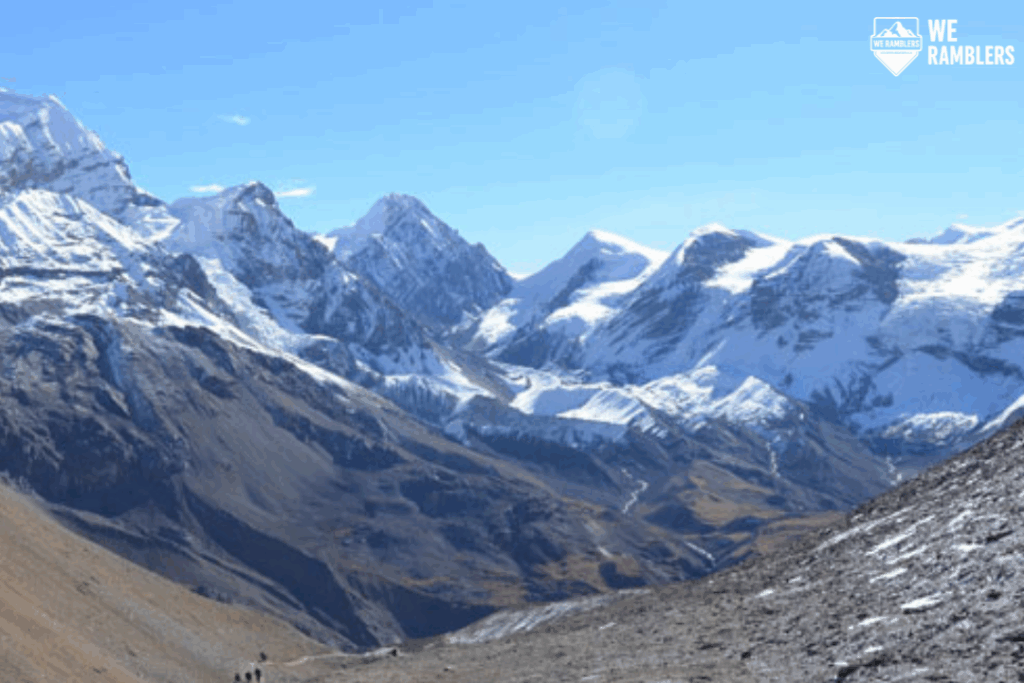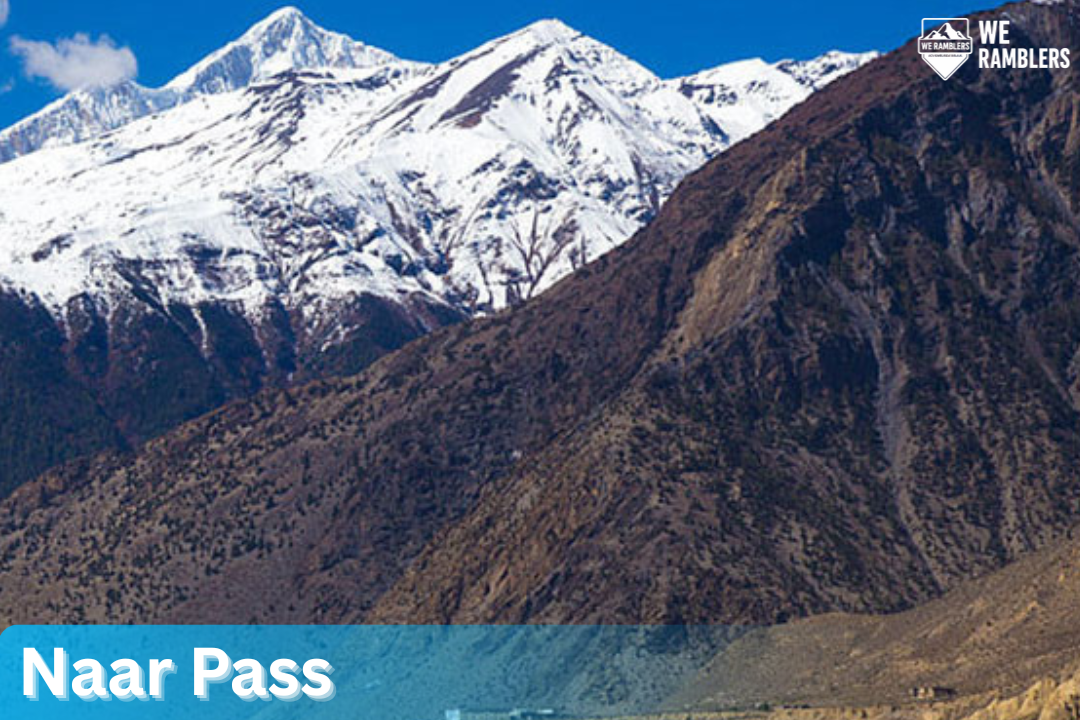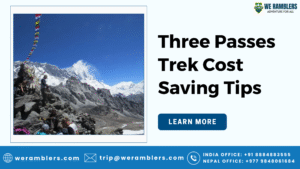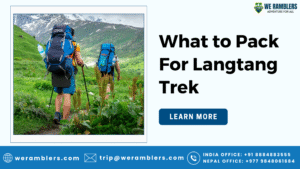Naar Pass Trek: The Untouched Gateway Between Nar-Phu and Upper Mustang
Rising to an altitude of approximately 5,400 meters, Naar Pass is a rugged, remote mountain crossing tucked deep within the Annapurna region of Nepal. For seasoned adventurers yearning to explore beyond the well-trodden paths of the classic Annapurna Circuit, the Naar Pass Trek presents a raw, immersive journey through some of the last untouched alpine trails of the Himalayas. This dramatic pass forms a natural bridge between the isolated Nar Phu Valley trek and the mystical lands of Upper Mustang, offering a high-altitude traverse filled with grandeur, silence, and challenge.
Often bypassed due to its demanding nature and remoteness, Naar Pass is part of the Annapurna hidden trails — quiet corridors where few footsteps echo. This trek caters to a special kind of traveler: those who thrive on solitude, high-mountain wilderness, and cultural depth. If you’re a high altitude trek Nepal enthusiast seeking an unfiltered encounter with nature, culture, and elevation, this might just be your most rewarding adventure yet. Here, you’ll find not just trails but untouched valleys, sacred mountains, and pure Himalayan silence that speaks directly to your soul.
What Makes Naar Pass Special
Unlike more frequented Himalayan trails, the Naar Pass Trek remains a pristine experience, a true embodiment of a wilderness trek Nepal. Traversing this route means stepping into an amphitheater of jagged peaks, rock-strewn ascents, and valleys untouched by modern infrastructure. The pass itself is rarely visited, making it one of the most remote and thrilling high altitude trek Nepal options.
What elevates Naar Pass above other crossings is not just its physical altitude but its emotional and visual impact. Trekkers move through rugged trails that have witnessed the passage of centuries-old trading caravans, nomadic herders, and ancient pilgrims. The isolation is intense, the quiet is absolute, and the landscapes shift dramatically, from deep canyons and glacial streams to windswept alpine ridges. It’s the kind of place where you’re more likely to see a Himalayan griffon than another human being.
Each bend offers cinematic landscapes that shift with the hours of the day. Morning light paints the snowy peaks in soft gold, while evenings drape the entire valley in hues of crimson and lavender. For wilderness lovers, this is as pure and raw as the Himalayas get.
Naar and Phu Villages: The Cultural Soul
Set against the wild terrain are the mystical Naar and Phu villages, where time seems to have stood still. These stone-built settlements are the heartbeat of the Nar Phu Valley trek, offering a rare glimpse into Tibetan-influenced Himalayan life. From chortens and mani walls to centuries-old gompas perched on cliffs, the villages reflect a spiritual legacy woven deeply into daily routines.
Villagers live by seasonal rhythms—herding yaks, cultivating barley, and celebrating colorful Buddhist festivals. Staying in these villages is a highlight of cultural trekking in Nepal, as it allows you to interact with hospitable locals, enjoy butter tea in a smoky kitchen, and sleep beneath hand-carved wooden beams. This cultural immersion, set in such remote highlands, is not just scenic but profoundly moving.
Walking through the villages, you hear the soft chants of monks, see children spinning prayer wheels, and witness vibrant festivals that have survived centuries. The harmony between people and nature here remains one of the greatest cultural experiences in the Himalayas.
Best Time to Trek Naar Pass
The best time to trek Naar Pass falls in two windows: late March to May and September to early November. These months offer the most stable weather, clearer skies, and safer trail conditions. In spring, wildflowers bloom across alpine meadows, while autumn provides sharp mountain views and golden hues.
Avoid the monsoon season (June to August), as trails become slippery and landslide-prone, especially on narrow ridges. Similarly, winter (late November to February) brings deep snow and icy winds that can block the Nar Phu to Mustang route completely. Given the unpredictability of weather on such remote treks in Nepal, it’s essential to monitor local updates and check with guides before committing to the pass crossing.
During prime trekking seasons, crystal-clear nights offer unforgettable stargazing opportunities, while the days present unobstructed views of towering peaks. The seasonal contrast makes this trek even more dynamic and memorable.
Naar Pass Itinerary Overview
A classic Naar Pass itinerary starts from Koto in the Manang district, gradually gaining altitude and culture as you move through Meta, Kyang, and into Phu village. After exploring Phu and retracing back to Nar village, the trail then sets its sights on the pass itself.
Suggested Naar Pass Itinerary Highlights:
- Day 1–2: Kathmandu to Koto (via Besisahar and jeep ride)
- Day 3–4: Trek to Meta and then to Phu (acclimatize and explore)
- Day 5: Return to Nar village via Nar Phedi
- Day 6: Acclimatize and prepare for Naar Pass
- Day 7: Cross Naar Pass (early start, long day) to Lhomi or Yak Kharka
- Day 8–10: Descend into Upper Mustang side or rejoin Annapurna Circuit towards Jomsom
Expect long walking hours, sparse facilities, and steep ascents. This trek suits those ready for alpine challenges, with optional extensions to the Nar Phu Valley trek or a drop into the mysterious landscapes of Upper Mustang. Each camp is both a rest point and a chapter in this rare Himalayan narrative.
The itinerary offers breathtaking diversity, from forests and glacial rivers to open alpine tundra. Each step brings you closer to some of the most breathtaking and isolated parts of the Himalayas.
Permits and Rules for Restricted Access
Because this route lies within a restricted zone, obtaining a Nar Phu restricted area permit is mandatory. Additionally, you’ll need the Annapurna Conservation Area Permit (ACAP). Independent trekking is not allowed; a registered guide and at least two trekkers in a group are required to enter the Nar-Phu region.
Permit Checklist:
- Nar Phu RAP (USD 100 for first 7 days)
- ACAP (approx. USD 30)
- Valid passport copies
- Passport-sized photos
- TIMS card (depending on agency)
Permits can be arranged in Kathmandu or through a licensed trekking agency. Your guide usually handles this process.
These regulations protect both the environment and local communities, ensuring that the cultural and ecological treasures of the Nar Phu region remain intact for future generations.

Physical Preparation & Difficulty
The Naar Pass Trek is not for beginners. With extended periods above 4,000 meters and minimal settlements between major stops, physical endurance and mental resilience are crucial. This trail is ideal for those who have completed other trekking in Nepal routes and want to challenge themselves further.
Training should include cardio, strength, and altitude conditioning. Expect tough terrain: loose scree, high winds, and thin air. Carrying your gear or relying on porters can make a significant difference. This trek demands more than just fitness—it requires the determination to navigate nature at its most raw.
Mental preparation is equally critical. Long days in isolated terrain test not only your body but your ability to remain calm, focused, and self-sufficient under varying conditions.
Altitude Risks and Safety Advice
At over 5,000 meters, Naar Pass presents a serious risk of Acute Mountain Sickness (AMS). Proper acclimatization, hydration, and slow ascent are essential. Symptoms like headache, nausea, and dizziness should not be ignored.
Safety Essentials:
- Carry Diamox as a preventive measure
- Drink at least 3 liters of water daily
- Ascend slowly and plan rest days
- Ensure your insurance covers high-altitude trekking
- Carry a satellite phone or Garmin InReach for emergencies
Having an experienced guide not only helps with logistics but also enhances safety during altitude emergencies on this high altitude trek Nepal.
Familiarizing yourself with early AMS symptoms, such as loss of appetite and insomnia, can be lifesaving. Your guide’s expertise is your most valuable safety asset.
Packing Essentials for The Naar Pass Trek
Packing smart is crucial for such a remote and cold journey. Nights drop below freezing, and the wind at the pass can be brutal.
Essential Items:
- Insulated down jacket, thermal layers, and waterproof gear
- Sturdy boots and crampons (depending on snow)
- Water purifier tablets or filters
- Compact medical kit with AMS medication
- Sleeping bag rated -10°C or lower
- Copies of permits, passport, and sufficient cash (no ATMs en route)
If you’re planning to go unsupported or camp, include ultralight tents, cooking equipment, and freeze-dried meals. Even teahouses in this zone may be closed outside peak seasons.
Don’t forget high-calorie snacks, layered clothing for fluctuating temperatures, headlamps with spare batteries, sunscreen, lip balm, and trekking poles to assist on descents.
Wildlife, Scenery & Landscapes
The Naar Pass Trek is a cinematographer’s dream. From green valleys to snowy passes and rust-colored cliffs, each segment offers arresting visuals. Expect to spot blue sheep grazing on steep slopes, yaks crossing high ridges, and Himalayan griffons soaring overhead.
The scenery transitions from lush pine forests near Koto to barren alpine zones above Nar. Views from the pass showcase Pisang Peak, Gangapurna, and distant views of the Upper Mustang connection — an ethereal meeting of rock and sky. The surreal atmosphere is what makes this one of the most dramatic trekking in Nepal routes.
In rare moments, lucky trekkers might even witness elusive snow leopards or golden eagles circling the ridgelines. Every angle offers another postcard-worthy frame.
Extension to Upper Mustang
Once you’ve crossed the Nar Phu to Mustang route, you’ll enter a strikingly different world. The Upper Mustang connection begins with arid valleys, ochre-colored cliffs, and walled villages resembling Tibetan settlements. Cultural landmarks shift from ornate gompas to whitewashed chortens with prayer flags fluttering in dry wind.
Permits are required to enter Upper Mustang (USD 500 for 10 days), and the journey typically ends in Jomsom, where trekkers can fly back to Pokhara. Those with more time can continue northward to Lo Manthang, the ancient walled capital of the former Mustang Kingdom. The contrast of regions makes this route an unforgettable study in natural and cultural duality.
The blend of Upper Mustang’s barren landscape and rich Buddhist culture creates one of the most diverse and fascinating Himalayan experiences.
Final Thoughts & Reflections
The Naar Pass Trek is not just another trail in the Himalayas—it’s a pilgrimage into solitude, tradition, and resilience. Every wind-battered ridge and prayer-flag-laced stupa stands as a reminder of the ancient heartbeat of the mountains. The physical challenges you overcome are matched by the emotional revelations along the way.
For those drawn to remote treks in Nepal that reward both body and soul, Naar Pass offers something extraordinary. It’s where isolation becomes introspection, and hardship becomes harmony with the world around you. If you’re seeking a true adventure trekking in Nepal, off the grid and deeply rooted in culture and geography, the Naar Pass Trek awaits.
Each step brings new challenges, but also unforgettable rewards — the laughter of children in ancient villages, the silent beauty of towering peaks, and the personal growth that only such a profound wilderness experience can offer.
Book Your Trekking Package with We Ramblers
For those planning the Naar Pass Trek, We Ramblers offers expertly guided trekking packages that handle everything from permits to logistics. Our experienced guides ensure safety, acclimatization, and cultural immersion throughout this challenging journey. Whether you’re venturing into Nar Phu or extending into Upper Mustang, our team provides comprehensive support, allowing trekkers to focus entirely on the adventure. Give us a call now to learn more about our packages.





